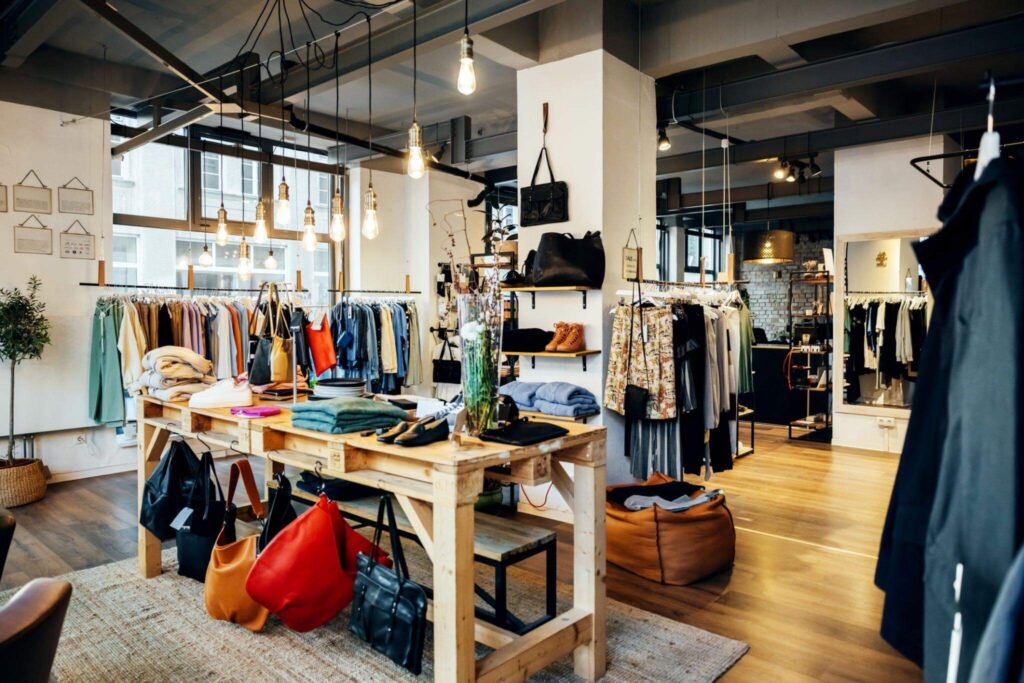Starting the process of developing your apparel line into a sought-after retail brand? Look nowhere else. This complete guide outlines how to get your clothing brand in stores. We’ll take you through each phase, from drawing to hanger, highlighting the strategies and insights that will guarantee your place on those desired shop shelves and open the door to long-term retail success. Get ready to learn how to realize your fashion ideas in the fast-paced world of retail, whether you’re a passionate novice or an experienced designer.
Understanding and Navigating the Retail Landscape
Before diving into the topic of “how to get clothing into retail stores” we need to understand the basics first. To successfully position your apparel brand in the retail industry, you must have an in-depth understanding of this dynamic and ever-changing environment.
Understanding the complexities of this market will enable you to make wise selections and strategic decisions that will strengthen your brand’s presence. Here is a deeper look at some important factors to have in mind when you enter the world of retail:

1. Market Research
Do considerable market study before setting sail. Determine the hottest fashion trends, customer preferences, and market gaps. This information will direct your brand’s positioning and assist you in customizing your services to satisfy the needs of your target market.
2. Retail Formats
Many different retail types exist, including high-end boutiques, department stores, and internet markets. Each format has a different consumer base and necessitates a different entrance strategy. To decide where your brand fits best, consider the advantages and disadvantages of each format.
3. Target Audience
Have a thorough understanding of your audience. Examine their characteristics, tastes, and purchasing patterns. Your product design, pricing, and marketing decisions will be informed by this information, ensuring that the proper customers are attracted to your brand.
4. Competitor Analysis
Before putting your brand in a clothes store, examine the companies that have already reserved a spot in retail establishments. Examine their product lines, price plans, and branding tactics. You may locate niches to place your brand in by using this technique to detect market gaps.

5. Brand Identity
There is one very common question “How do I brand my own clothing line?” In the retail wilderness, your brand’s identity serves as your compass. Create a memorable brand story, specify your essential principles, and create a distinctive visual identity. This coherent story will draw in merchants and clients that share your goal.
6. Retail Relationships
Building solid connections with merchants is frequently necessary to successfully navigate the retail market. Approach potential partners With a persuasive argument emphasizing the value your brand adds to their shop. Making sincere connections may lead to partnerships and top-shelf placement.
7. Adaptability
The retail environment is dynamic. Retail formats fluctuate, as well as trends and consumer preferences. Accept flexibility as a crucial quality for success. Be ready to adjust your tactics and products in response to changing market conditions.
8. Online and Offline Synergy
The difference between online and offline retail is harder now that we live in a digital world. Make use of e-commerce’s strength to support your physical retail presence. The exposure and consumer engagement of your brand may both be improved by a flawless Omni channel strategy.
How to Build a Strong Brand Identity for Retail Success?

A strong brand identity is your North Star in the cutthroat world of retail, helping shoppers recognise, believe in, and pick your clothes brand above competitors. In addition to being an art, creating a compelling and consistent brand identity is crucial for long-term success. Here is a guide to help you create a unique brand identity that attracts your target market:
1. Define Your Brand Essence
Find the heart of your clothes brand by digging deep. What principles, feelings, and goals does it represent? The basis for your whole brand identity will be this core value.
2. Know Your Audience
Your brand identity should reflect your target audience’s interests and objectives. Consider their demographics, habits, and interests to develop a brand that communicates to them directly.
3. Craft a Unique Brand Story and a Brand Voice
A compelling brand always has a tale to tell. Describe the process you went through to develop your apparel brand. Emphasize your unique selling points, such as your sourcing strategy, design aesthetic, or dedication to sustainability.
Your brand’s voice is how it communicates with your target market. Is it approachable, commanding, lighthearted, or formal? Establish a tone that is resonant with your intended audience.
We Help Clothing Brands Get Retail Ready
Partner With A Clothing Manufacturer
Get A Free Consultation4. Develop Visual Elements
Visuals may help people recognise a brand. Create a memorable logo, pick a distinctive color scheme, and pick typography that conveys the character of your business. The key is consistency among these components.
5. Embrace Authenticity
The cornerstone to successful brand identification is authenticity, especially for custom clothing manufacturers for startups. Stay faithful to your beliefs and commitments. Ensure that your brand’s identity accurately reflects who you are, since customers can tell when something is fake from a mile away.

6. Evolve with Purpose and Leverage Emotional Connections
You may need to change your identification as your brand grows. However, These modifications should be intentional and consistent with your brand’s core. Avoid sudden changes that might mislead your viewers.
A powerful brand identity triggers emotional connections. Engage your audience’s emotions, whether those of empowerment, joy, or nostalgia. These bonds foster enduring brand loyalty.
7. Seek Feedback
Engage your audience in the process of shaping your brand’s identity, even in the context of “What is a technical pack“. Invite input on innovative product ideas, brand messages, or logo designs. This not only enhances your brand’s authenticity but also fosters greater engagement and participation.
How to Get Your Clothing in Stores?

“How to get my clothing brand in stores?” is one of the hardest questions for every fashion entrepreneur. It represents a concrete step in reaching out to more people and growing your brand. If you’re yearning to have your creations displayed at retail clothing stores, use these concrete measures to get noticed:
Perfect Your Product
Make sure your clothing line is ready for prime time before contacting clothing retailers. Create a unified collection highlighting your business’s distinctiveness and superior workmanship. Your items should be distinctive and appealing to the businesses’ target customers.
Research Your Target Stores
Not every store is made equally. Find retail clothing store locations through research that are compatible with the aesthetics and principles of your brand. Research their current product offerings, price points, and clientele to ensure a fit.
Craft a Compelling Pitch and Build a Professional Presentation
Your pitch serves as a clothing retailer‘s introduction to your brand. Create a pitch that clearly explains the history of your company, what makes your clothing line unique, and why it would be a good fit for their store.
Make an aesthetically engaging presentation that features the lookbook, product photos, and any press mentions or awards your clothing business has won. This presentation must convey your brand’s core and show how marketable it is.
Network and Attend Trade Shows
Trade exhibitions and industry gatherings offer fantastic chances to meet retail customers. Attend relevant meetings to network, present your concepts, and get knowledge of the retail environment.
Approach Buyers and Store Owners and Provide Samples for Evaluation

To get clothing brands in stores, speak with the store decision-makers you are targeting. Make calls or write individual emails to indicate your interest in working together. Explain how your clothing line might improve what they offer in their shop.
Giving stores samples to evaluate your goods’ caliber, fit, and style may have a big influence. A range of items should be included to reflect the diversity of your collection.
Negotiate Terms and Pricing
Be ready to bargain when a store expresses interest. Discuss the cost of clothing manufacturers, the conditions of payment, and the probable volumes. Make sure both parties will benefit from the agreement.
Offer Marketing Support and Plan a Successful Launch
Offer to give marketing materials, such as flyers, banners, or social media posts, to advertise your items within the store to sweeten the transaction. Plan a launch event or campaign with the clothing retailer to expose your apparel line to their clientele. A good launch may generate attention and increase retail foot traffic.
Maintain Relationships and Expand to More Stores
For continuous success, establishing trusting relationships with traders is essential. Regularly communicate, get Feedback, and modify your strategy to suit client preferences. Use your success with one retailer as a springboard to contact more clothing retailers. Your proposal may be even more persuasive, given your track record of success.
Exploring Collaborative Storefront Concepts

Take into account using a collaborative storefront approach in your efforts to get your apparel line into retail clothing store locations. This unique approach entails collaborating with complementary businesses to provide a shared retail environment with a distinctive shopping experience. Here’s how to apply this idea to your situation:
Synergy of Brands
Work with companies with a comparable target market yet provide a variety of product categories. For instance, collaborate with an eco-friendly accessory company if your clothesline focuses on sustainable fashion. This collaboration can offer a one-stop purchasing experience while attracting a larger client base.
Shared Retail Space
Consider a shared retail space where each brand has its own defined section as an alternative to conventional shop locations. Customers are inspired to explore various items, stimulating creativity and a sense of community.
Curated Shopping Experience
Make themed areas in the communal area, each devoted to a certain brand. With this carefully chosen approach, shopping is more engaging and cross-brand discovery is encouraged.
Collaborative Events
Use the shared retail area to host collaborative events, workshops, or pop-up stores. The combined power of all participating businesses may be utilized in these events to increase foot traffic and media coverage.
Digital Integration
Include your internet presence in the collaborative concept. Create an area on your websites or a shared website where customers can browse all the participating brands. This internet hub can facilitate E-commerce sales.
Storytelling Opportunities
Utilize your store space’s collaborative aspects to present an engaging tale. Draw attention to each brand’s history, common values, and role in creating a distinctive shopping experience.
Flexibility and Cost-sharing
Financial terms tend to be more adaptable in collaborative shops, which is particularly advantageous when considering “How to find clothing manufacturers“. This approach offers brands a cost-effective means to establish a physical retail presence, as they can collectively share expenses such as rent, electricity, and operational costs.
Key Takeaways
Remember that thriving in the fierce fashion industry requires a strategic combination of originality, perseverance, and flexibility as you embark on the exciting adventure of bringing your clothing brand into retail clothing stores. Remember that your apparel brand’s journey doesn’t finish when it finds a place in retailers.
It’s the start of a brand-new chapter full of chances for development, progress, and further market expansion. Keep an eye on market developments, continue cultivating connections with significant clothing retailers, and be open to new approaches that may help strengthen your brand’s visibility even more. Set up to see your brand bloom as it enters the arena of successful retail!







